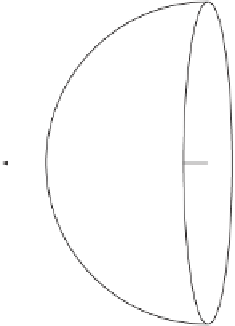Graphics Programs Reference
In-Depth Information
P
P
*
Q
R
R
(a)
(b)
AB
(c)
(d)
Figure 4.29: Principle of Curvilinear Perspective.
a useful artist's tool to draw the curvilinear perspective projection of any scene on a
circle of radius
sR
(
π/
2) in a single step.
4.7 Cubic Panoramic Projection
The principle of the cubic panoramic projection is similar to those of the other panoramic
projections. We imagine an observer located at the center of a cube (Figure 4.30a) and
looking at the three-dimensional scene outside. Everything the observer sees is etched on
the sides of the cube (or is painted there by the observer), and the cube is then flattened
into six squares connected as in Figure 4.30b,c. This creates a full 360
◦
panorama in
six parts.
The main advantage of the cubic panoramic projection is the absence of distor-
tion. Straight lines are projected into straight lines, and the only deviation from total
linearity is discontinuous slopes at the boundaries between the six planes of the cube.
This behavior is best illustrated by Figure 4.32 (courtesy of Shinji Araya) but is also
demonstrated here rigorously by means of an example.













Search WWH ::

Custom Search